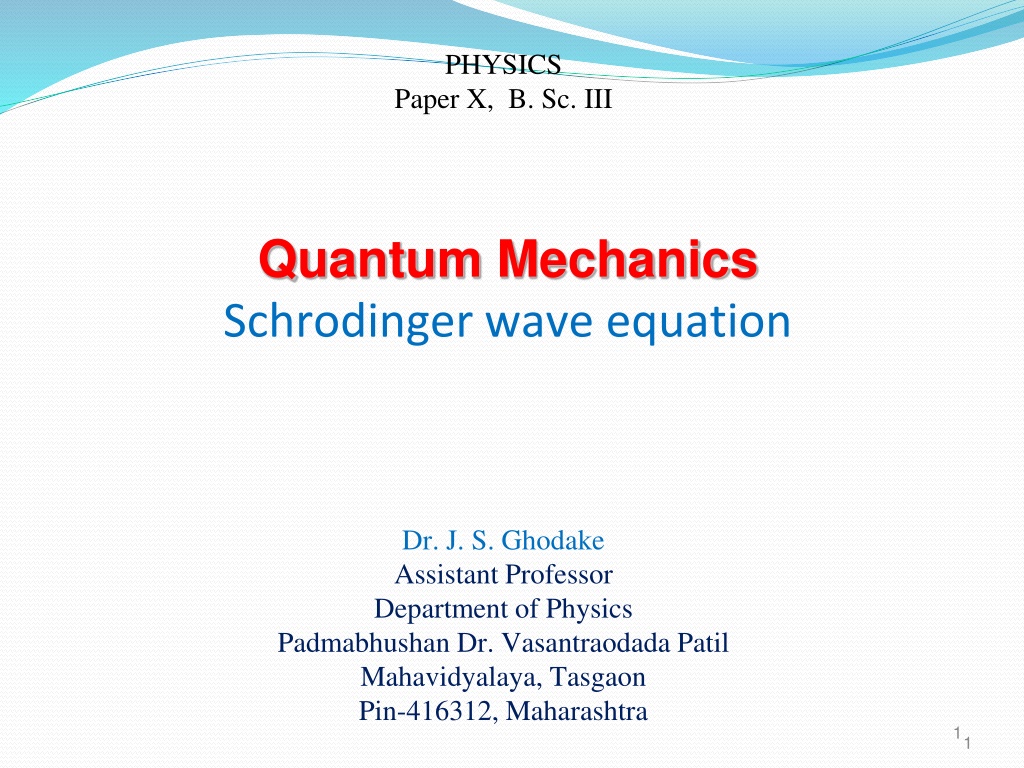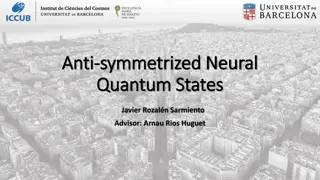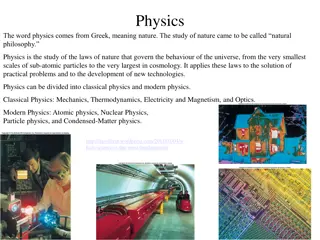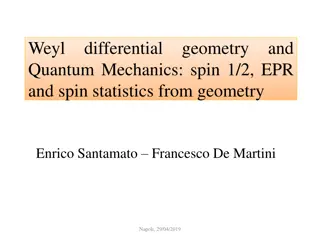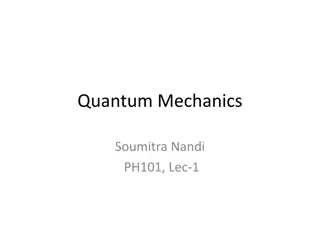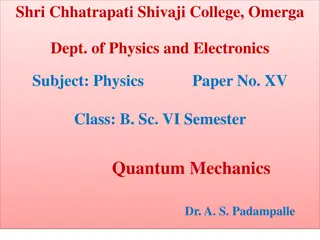Quantum Mechanics
Quantum mechanics delves into the behavior of atomic systems, emphasizing wave-particle duality through Schrödinger's wave equation. Wave functions provide insights into probability density, ensuring the particle's presence across positions. Normalizing the wave function is crucial for maintaining unity probability. Additionally, specific requirements for wave functions dictate finiteness, singularity, and differentiability, ensuring accurate representation in quantum physics.
Download Presentation

Please find below an Image/Link to download the presentation.
The content on the website is provided AS IS for your information and personal use only. It may not be sold, licensed, or shared on other websites without obtaining consent from the author.If you encounter any issues during the download, it is possible that the publisher has removed the file from their server.
You are allowed to download the files provided on this website for personal or commercial use, subject to the condition that they are used lawfully. All files are the property of their respective owners.
The content on the website is provided AS IS for your information and personal use only. It may not be sold, licensed, or shared on other websites without obtaining consent from the author.
E N D
Presentation Transcript
PHYSICS Paper X, B. Sc. III Quantum Mechanics Schrodinger wave equation Dr. J. S. Ghodake Assistant Professor Department of Physics Padmabhushan Dr. Vasantraodada Patil Mahavidyalaya, Tasgaon Pin-416312, Maharashtra 1 1
A careful analysis of the process of observation in atomic physics has shown that the subatomic particles have no meaning as isolated entities, but can only be understood as interconnections between the preparation of an experiment and the subsequent measurement. - Erwin Schr dinger 2
Introduction The most important characteristics features of quantum theory is the wave particle duality. According to de Broglie hypothesis, wave associated with moving particle in matter. This waves are controlled by particle having mass m , velocity v and momentum p . The wavelength of wave is h = mv The scientist Schrodinger in 1926 starting with de Broglie relationship between momentum of the particle and wavelength of wave, developed a mathematical theory known as wave mechanics mechanics or quantum 3
Quantum mrchanics describes the behaviour of atomic systems and their interaction with other particles and electromagnetic radiations. Behavior of particle should be mathematically described by wave function . Wave function - as a measure of the probability of finding a particle around a particular position. Since probability must be real and non-negative may be positive, negative or complex . 4
The square of magnitude of the wave function are called probability density, which is proportional to probability of finding the particle at that time. The probability P(x) dx of a particle being between x and x + dx is given in the equation = ) * ( ) ( , ( , ) P x dx x t x t dx The probability of the particle being between x1and x2is x 2 = * P dx x 1 5
The probability of the particle being somewhere must be equal to unity. So that the wave function must be normalized. Then normalization condition becomes + x = * ( , ) ( , ) 1 t x t dx 6
Requirements of Wave Functions Wave function must obey the following conditions, 1. The wave function must be finite everywhere. 2. The wave function must be single valued. 3. The wave function must be twice differentiable. This means that wave function and its derivative must be continuous. 4. In order to normalize a wave function, it must approach zero as the value of x tends to infinity. 7
Schrodingers time dependant equation In quantum mechanics, the Schrodinger s equation is a partial differential equation that describes how the quantum state of a physical system changes with time. The Schrodinger s equation is the fundamental equation of physics for describing quantum mechanical behavior. To obtain Schrodinger s equation, let us consider general equation of wave motion y=A exp [i(kx -wt)] Where A-is the amplitude k-is the wave vector w-is the angular frequency 8
The wave function for a particle moving freely along positive x axis is specified by equation = ( ) i kx wt Ae Einstein s theory of light, energy E of a photon is proportional to the frequency , E = h From de Broglie hypothesis, the wavelength h h = = mv p We can write above equations as h 2 = = 2 = E h w 2 h h 2 = = = p k 9
Let us consider above equations = ( ) i kx wt Ae and = = E w p k We get i ( ) px Et = Ae 10
i ( ) px Et = Ae (1) Now consider Differentiating above equation (1) with respect x , we get i ip ( ) px Et = Ae x Again differentiating above equation (1) with respect x , we get i 2 2 p ( ) px Et = Ae 2 2 x 2 x 2 2 p = 2 This equation gives 2 (2) 2 = 2 p 2 x Differentiating above equation with respect t , we get 11
Differentiating above equation (1) with respect t, we get i iE ( ) px Et = Ae t t iE = This equation gives t = E i = E i (3) t 12
When speed of particle is small compared to velocity of light, the total energy E of a particle is sum of kinetic energy and potential energy 2 p =2 + E V m Multiplying on both sides by 2 p E =2 + V m Substituting equation (2) and (3), we get t x 2 2 (4) = + V i 2 2 m This is time-dependent Schrodinger wave equation for a particle of energy E moving in a potential V in one dimension. 13
Schrodingers time independent The Schrodinger s Equation is the fundamental equation of Quantum Mechanics. Schrodinger's equation simplified by removing all time dependant part we get Schrodingers time independent equation m t 2 ) , ( t x = where x 2 2 = + i V (5) 2 This equation can be solved by separation of variables method = (6) ( , ) ( ) ( ) x t x t Let Substitute equation (6) in equation (5), we get 14
t x 2 2 = + V i 2 2 m t x 2 2 = + V i 2 2 m Dividing above equation throughout by 2 21 1 = + i V 2 2 t m x The right hand side of above equation is a function of x only and left hand side is a function of t . This is possible only when both sides are equal to some constant , say E, 15
2 21 Therefore we write + = V E (7) 2 2 m x 1 = i E (8) t From equation (7) and (8) it is observed that the constant E has dimensions of energy. Therefore (7) can be written as 2 x 2 m + ) = ( 0 E V 2 2 This is Schrodinger s time-independent wave equation 16
Applications Schrodinger Wave Equation can apply to One and Three Dimensional problem Linear harmonic oscillator Step potential Potential barrier Hydrogen atom 17
